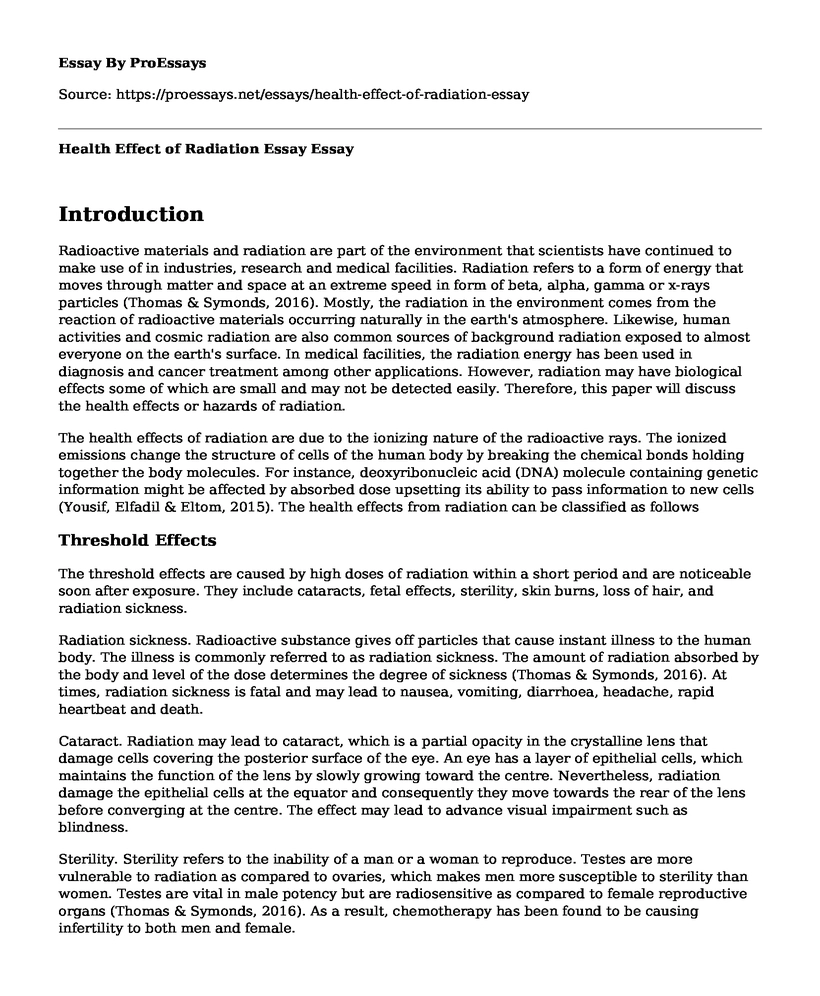Introduction
Radioactive materials and radiation are part of the environment that scientists have continued to make use of in industries, research and medical facilities. Radiation refers to a form of energy that moves through matter and space at an extreme speed in form of beta, alpha, gamma or x-rays particles (Thomas & Symonds, 2016). Mostly, the radiation in the environment comes from the reaction of radioactive materials occurring naturally in the earth's atmosphere. Likewise, human activities and cosmic radiation are also common sources of background radiation exposed to almost everyone on the earth's surface. In medical facilities, the radiation energy has been used in diagnosis and cancer treatment among other applications. However, radiation may have biological effects some of which are small and may not be detected easily. Therefore, this paper will discuss the health effects or hazards of radiation.
The health effects of radiation are due to the ionizing nature of the radioactive rays. The ionized emissions change the structure of cells of the human body by breaking the chemical bonds holding together the body molecules. For instance, deoxyribonucleic acid (DNA) molecule containing genetic information might be affected by absorbed dose upsetting its ability to pass information to new cells (Yousif, Elfadil & Eltom, 2015). The health effects from radiation can be classified as follows
Threshold Effects
The threshold effects are caused by high doses of radiation within a short period and are noticeable soon after exposure. They include cataracts, fetal effects, sterility, skin burns, loss of hair, and radiation sickness.
Radiation sickness. Radioactive substance gives off particles that cause instant illness to the human body. The illness is commonly referred to as radiation sickness. The amount of radiation absorbed by the body and level of the dose determines the degree of sickness (Thomas & Symonds, 2016). At times, radiation sickness is fatal and may lead to nausea, vomiting, diarrhoea, headache, rapid heartbeat and death.
Cataract. Radiation may lead to cataract, which is a partial opacity in the crystalline lens that damage cells covering the posterior surface of the eye. An eye has a layer of epithelial cells, which maintains the function of the lens by slowly growing toward the centre. Nevertheless, radiation damage the epithelial cells at the equator and consequently they move towards the rear of the lens before converging at the centre. The effect may lead to advance visual impairment such as blindness.
Sterility. Sterility refers to the inability of a man or a woman to reproduce. Testes are more vulnerable to radiation as compared to ovaries, which makes men more susceptible to sterility than women. Testes are vital in male potency but are radiosensitive as compared to female reproductive organs (Thomas & Symonds, 2016). As a result, chemotherapy has been found to be causing infertility to both men and female.
Non-Threshold Effects
The non-threshold effects of radiation appear after years of exposure. The chances of the delayed effects increase with severity and size of dose absorbed. In some cases, the person exposed to radiation may not be affected but their offspring may suffer from these effects
Cancer. Radiation-induced cancer is the most common non-threshold effect. An intensive wavelength of ionizing radiation has enough energy to not only damage DNA but also cause cancer (Yousif, Elfadil & Eltom, 2015). Leukaemia and skin cancer is the most commonly attributed to occupational exposure, medical procedures, natural radiation or nuclear accidents.
Genetic effects. The ionizing radiation alters and damages DNA mutation. As a result, the reproduction cells are affected and this can be transmitted to the next generation. Some of the genetic effects include birth defects, sex ratio, and chromosome abnormalities.
Conclusion
In conclusion, although background radiation is common and human body has developed a defensive mechanism, prolonged and severe exposure to radiation leads to instant or delayed effects. Medics have come up with ways of getting the best out of radiation energy but they are still challenges, as radioactive materials remain hazardous to human life. Therefore, radiation and radioactive materials should be handled carefully to avoid severe effects.
References
Thomas, G. A., & Symonds, P. (2016). Radiation exposure and health effects-is it time toreassess the real consequences? Clinical Oncology, 28(4), 231-236.
Yousif, Y. M., Elfadil, M., & Eltom, G. E. K. (2015). Making Sense Of Radiation: AGuide to Radiation and its Health Effects. International Journal of Health andRehabilitation Sciences (IJHRS), 4(1), 57-64.
Cite this page
Health Effect of Radiation Essay. (2022, Jun 06). Retrieved from https://proessays.net/essays/health-effect-of-radiation-essay
If you are the original author of this essay and no longer wish to have it published on the ProEssays website, please click below to request its removal:
- Synthesis Essay on Impact of Telehealth on Health Outcomes
- Essay Sample on Pro-Choice Abortion
- Paper Example on Exercise for Health: Benefits of Physical Activity
- Essay on New Moves: A Program to Tackle Obesity & Eating Disorders in Teenage Girls
- Research Paper on Analysis of Stability in Underground Auditorium Structure
- Paper Example on Finite Element Method With Applications in Engineering
- Antibiotic for Treating Tuberculosis - Essay Example







